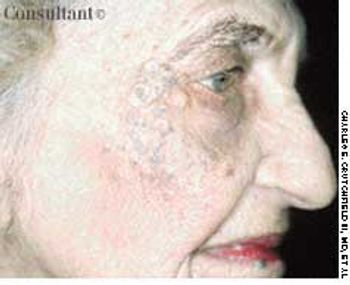
A 67-year-old woman sought medical treatment for the persistent, large “blackheads” on her face. Examination revealed diffusely thickened and yellowed skin with deep furrows. The periorbital and malar areas were studded with large open comedones.

A 67-year-old woman sought medical treatment for the persistent, large “blackheads” on her face. Examination revealed diffusely thickened and yellowed skin with deep furrows. The periorbital and malar areas were studded with large open comedones.
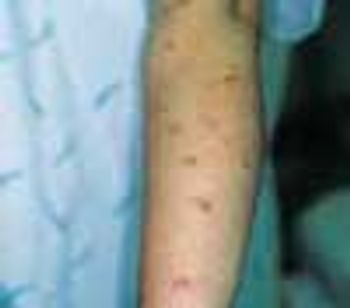
Pruritic urticarial papules and plaques of pregnancy (PUPPP). This cutaneous eruption usually occurs in the last trimester. It is seen only rarely in the postpartum period. PUPPP is more common in primigravidas but can occur in any pregnant patient.
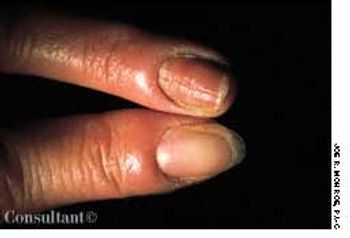
After 6 months of suffering with an infection on her finger and several failed courses of antibiotic therapy, a 53-year-old woman sought a second opinion.
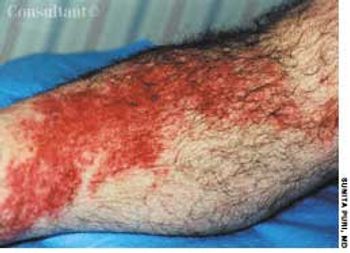
A 60-year-old man presented with redness, swelling, and pain on his right lower leg of 3 day's duration. He recalled being scratched by underbrush while hiking in the woods a few days earlier; the patient denied other recent trauma or insect bites.

A 71-year-old man, who had recently returned from a month in Europe, complained of left lower leg swelling and pain of 1-week's duration. For many years, this obese patient had chronic venous insufficiency of both legs and chronic osteoarthritis of the knees that severely limited his ability to walk. The patient was admitted to the hospital with extensive cellulitis of the left lower leg.

For 6 years, a 32-year-old man had a recurring rash on his back, shoulders, and chest. He stated that the rash appears in the spring, itches, and enlarges into ringlike areas. Previously, when treated with cephalexin, the rash had cleared within several weeks. Antifungal medication (econazole cream and oral terbinafine) had failed to resolve the rash.
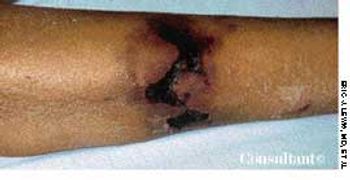
A 61-year-old woman who was receiving dialysis for diabetes-associated end-stage renal disease was hospitalized for care of an abdominal wound that had been debrided and closed. At this time, the patient had several large, indurated, red plaques with central, stellate, black eschars on her abdomen, left buttock, and legs. An early focus of ulceration was noted superior to the stapled incision.

A 63-year-old woman who was on long-term hemodialysis because of diabetic end-stage renal disease had a 7-month history of waxing and waning papules and plaques on the front of both legs. The asymptomatic multiple, discrete, slightly erythematous, round to oval lesions ranged from 5 mm to 3 × 4 cm. Several had heaped-up borders and contained central crust and keratotic debris; others were superficial ulcers with central eschars. The lesions improved only slightly following twice-daily application of a superpotent topical corticosteroid preparation.
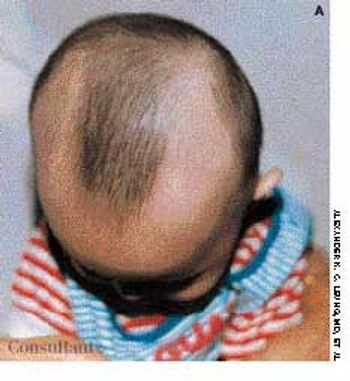
Concerned about their son's progressive hair loss during the last 6 months, his parents brought the 2-year-old into the office. The clinical appearance of hair loss extending in a band configuration around the temporal-occipital scalp margin confirmed the diagnosis of ophiasis.

A 55-year-old-man complained of joint stiffness and red, mildly tender plaques on his fingers. He had recently sustained a trauma to the hand while at his job as a fish handler. The condition was diagnosed as erysipeloid-a skin infection caused by the gram-positive bacillus Erysipelothrix rhusiopathiae.

A 41-year-old man presented with a 3-month history of itchy, scaly feet and right hand. The left hand was unaffected.

The nasal cellulitis that affects this 39-year-old woman began as right intranasal folliculitis. Because the patient was sensitive to many antibiotics, oral ciprofloxacin was prescribed.

Abnormalities of the hair shaft, whether traumatic or acquired, may result in hair breakage (which gives the appearance of failure of the hair to grow) and hair loss. Trichorrhexis nodosa-traumatic fractures of hair shaft-may result from UV exposure, permanent wave procedures, coloring of the hair, or the use of hot combs. The condition may also be congenital. The hairs have a broken, “flyaway” appearance, and characteristic grayish white nodules on the hair shaft can be seen with the naked eye.
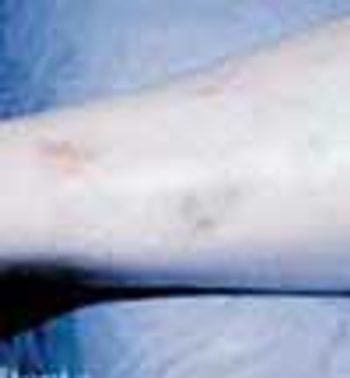
This is a multisystem disorder characterized by oral and genital aphthae. Other symptoms include a myriad of cutaneous findings; variable systemic features include uveitis, synovitis, meningoencephalitis, and large- and smaller-vessel vascular disease.
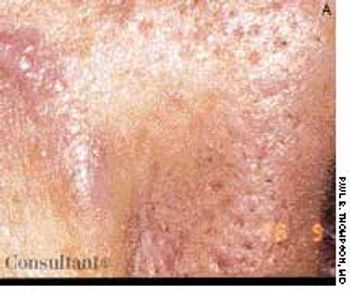
A minute, nonpigmented, innocuous-appearing papule on the nose of a 60-year-old man did not seem cause for alarm. However, a simple, 3-mm punch biopsy saved this patient's life.

During the last 3 months, scars had developed on the sternal area of a 25-year-old black woman. She recalls having punctured an acne pustule at the site just before the scar began to develop.

Periorbital, forehead, and nasal erythema, crusting, and pain typical of herpes zoster affected a 90-year-old woman. Reactivation of the latent varicella zoster is more common in the elderly and is attributed to impaired immunologic mechanisms.

A 6-year-old girl was evaluated in the emergency department for a leg rash that had spread to the buttocks. The lesions first appeared earlier in the day and worsened hourly. The child's mother reported that her daughter was in good health until a low-grade fever, nonproductive cough, sore throat, and headache developed 5 days earlier. The youngster also complained of neck pain with movement.

A 49-year-old farmer was hospitalized because of a 3-week history of intermittent fever, fatigue, anorexia, generalized myalgias, and malodorous sweating. A nonpruritic, nonhemorrhagic, maculopapular rash recently had developed on his arms, legs, and trunk. The reddish lesions were less than 1 cm in diameter. There was no history of antibiotic or antipyretic drug therapy, and no abnormalities were found on physical examination.
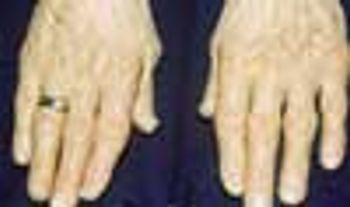
The 83-year-old woman whose hands are shown in photograph A had a severe flare of arthritis in the metacarpophalangeal and proximal interphalangeal (PIP) joints after corticosteroid therapy for her asthma was stopped. The clue to the diagnosis of psoriatic arthritis is in her fingernails, which show both pitting and onycholysis.
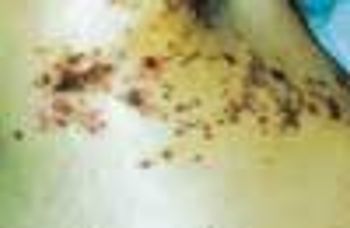
Ten days before presenting for evaluation, a 69-year-old man began to experience neuralgic pain and noticed the eruption of painful erythematous macules and papules on the right side of his chest. Within 24 to 72 hours, vesicles and pustules arose at the site. One week after onset, several of the lesions dried and crusted.
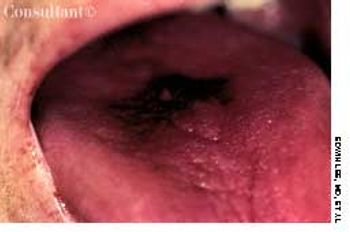
A 35-year-old HIV-positive man had a thick, black, otherwise asymptomatic patch on the top of his tongue. He did not have diabetes.

The painless lump on this 30-year-old woman's lip is a mucous cyst, or mucocele-the result of mucus retention within a salivary gland due to trauma or obstruction of a duct. This asymptomatic, dome-shaped, translucent, blue-white cyst is usually located on the inner surface of the lower lip or on the floor of the mouth.
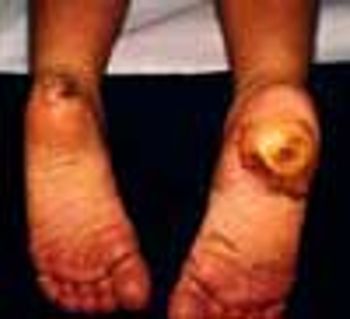
A 6-year-old girl presented with a huge ulcer on her right heel, seen here, that began as a minor laceration when she stepped on a rock several months earlier. On the left heel, there was a similar lesion in the process of healing that had also followed a minor injury. Her feet and hands were dry and hyperkeratotic.
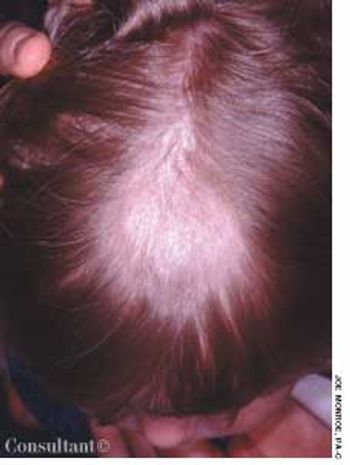
The parents of a 3-year-old girl sought evaluation of their daughter's hair loss. During the past several months, a large patch of alopecia with scaling had developed. The differential diagnosis included seborrhea, trichotillomania, and tinea capitis.